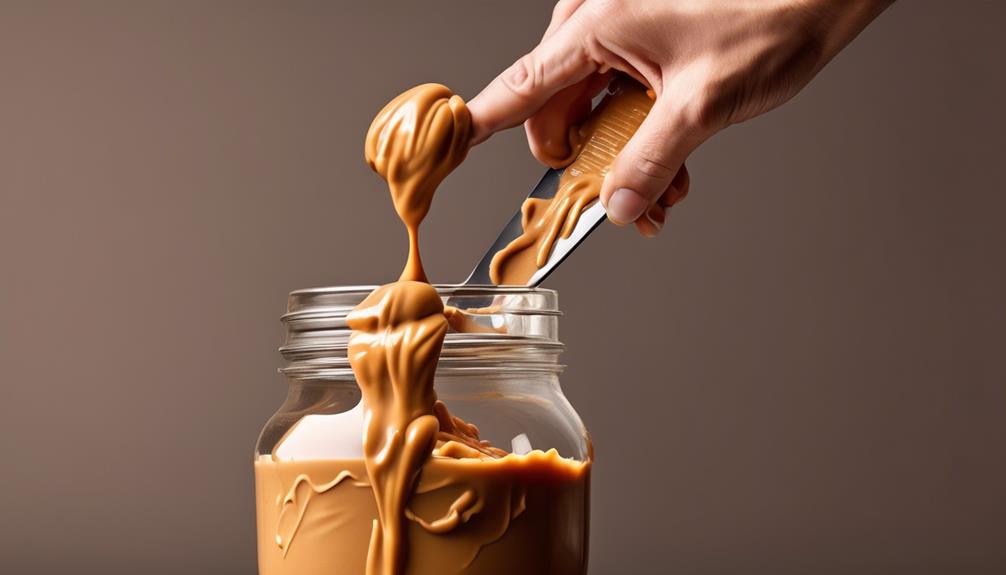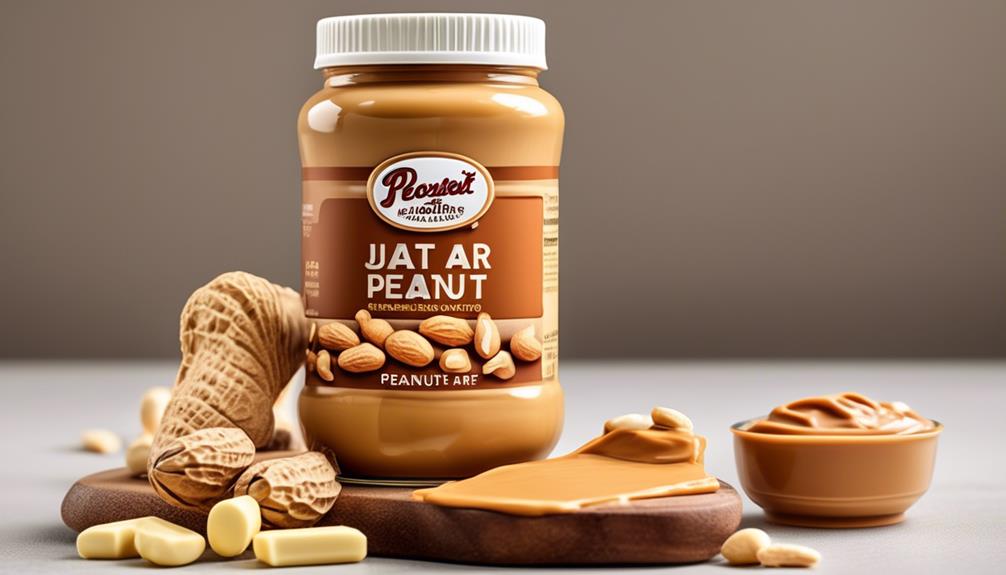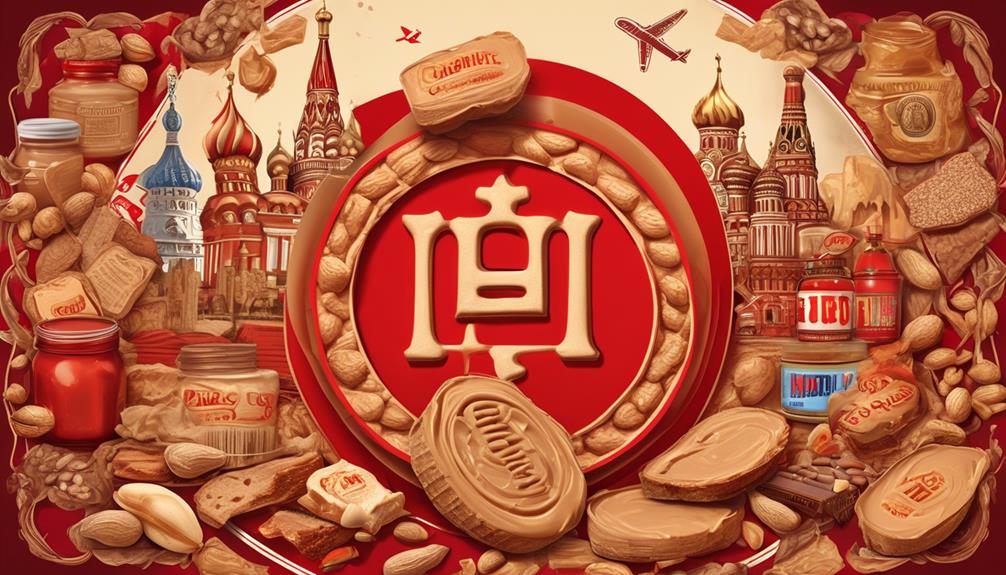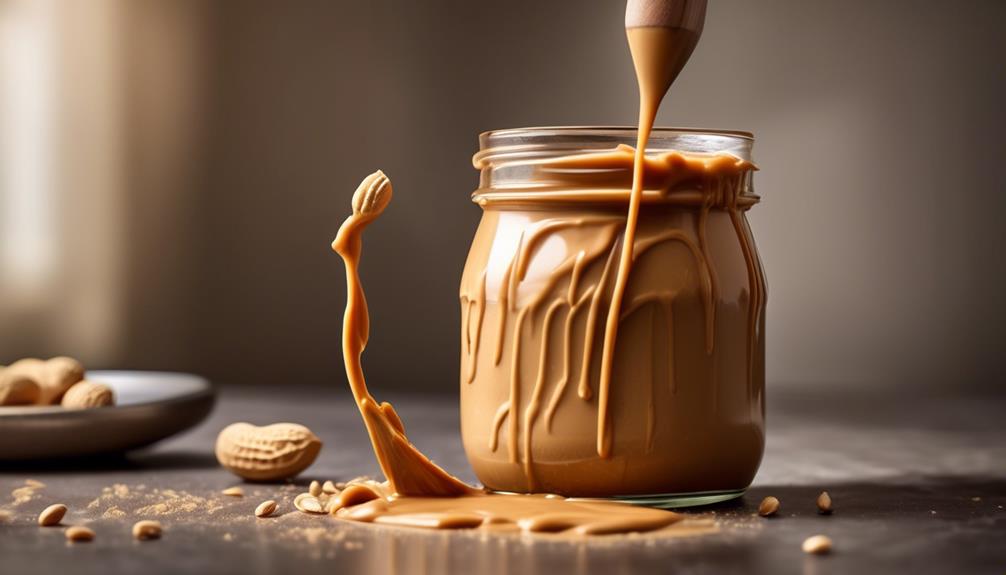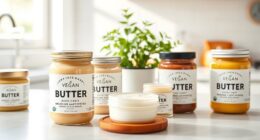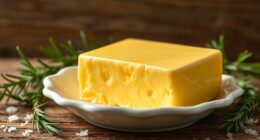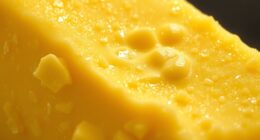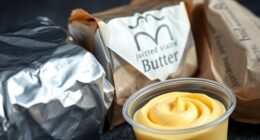When it comes to getting rid of leftover peanut butter, it can be as tricky as removing a stubborn sticker – it may require some effort, but the outcome is definitely worth it.
We've all been there, struggling to get every last bit of that creamy goodness out of the jar. But fear not, because we've got some clever tricks up our sleeves to help you with this sticky situation.
So, if you're tired of scraping and shaking to no avail, stick around and learn some creative ways to make that jar spotless and ready for its next use.
Key Takeaways
- Scrape and rinse methods, such as using a rubber spatula and warm, soapy water, are effective for removing leftover peanut butter from jars.
- A hot water rinse can help loosen and wash away remaining bits of peanut butter, ensuring a thorough clean of the jar.
- Using a soapy sponge to clean the interior of the jar and thoroughly rinsing it with hot water can also remove all residues for effective cleaning.
- Consider using a vinegar soak with hot water to break down lingering peanut butter residue, then rinse the jar with warm water afterwards.
Scrape the Jar Walls
We recommend using a rubber spatula to effectively scrape out any remaining peanut butter from the jar walls. Gently scrape along the edges and bottom to loosen and remove the peanut butter.
It's important to ensure that you reach into the corners and crevices to thoroughly clean the jar. By repeating the scraping process as needed, you can effectively remove all leftover peanut butter, leaving the jar empty and ready for washing.
Once the scraping is complete, wash the jar with warm, soapy water to remove any remaining residue. This method ensures that the jar walls are thoroughly cleaned and free from any traces of peanut butter.
The rubber spatula's flexibility and flat edge make it an ideal tool for this task, allowing for precise scraping and minimizing waste.
Hot Water Rinse

We recommend using a hot water rinse to effectively remove any leftover peanut butter residue.
This step helps to ensure a thorough clean of the jar, as hot water can help to loosen and wash away any remaining bits of peanut butter.
Additionally, the hot water rinse provides a simple and efficient way to prepare the jar for the next use.
Soapy Sponge Wipe
After wiping the remaining peanut butter from the jar with a soapy sponge, thoroughly rinse it with hot water to remove any soap and lingering residue. This step ensures the jar is clean and ready for reuse or recycling.
Here's what you need to know about the soapy sponge wipe and hot water rinse:
- Soapy Sponge Wipe
- Use a soapy sponge to clean the interior of the peanut butter jar thoroughly.
- Ensure all residues are removed for effective cleaning.
Vinegar Soak
For a thorough cleaning method, consider using a vinegar soak with hot water to remove any lingering peanut butter residue from the jar. Vinegar is a natural alternative to dishwashing soap and helps break down the residue, making it easier to clean out a peanut butter jar. To utilize this cleaning method effectively, fill the jar with hot water and add about 1/4 cup of vinegar. Let the jar sit for an hour, shaking it occasionally to ensure the vinegar reaches all areas. The peanut butter will float in the vinegar water, facilitating its removal. After the soak, rinse the jar with warm water to ensure all peanut butter is removed. The following table outlines the steps for using the vinegar soak method:
| Steps | Instructions |
|---|---|
| Fill the jar with hot water | Fill the jar with hot water. |
| Add about 1/4 cup of vinegar | Add about 1/4 cup of vinegar to the water in the jar. |
| Let the jar sit for an hour | Allow the jar to sit for an hour, shaking it occasionally to ensure thorough coverage. |
| Rinse the jar with hot water after soak | After soaking, rinse the jar with warm water to remove any remaining peanut butter residue. |
Scrape and Rinse
Using a rubber spatula, scrape out any remaining peanut butter from the jar before filling a quarter of the jar with hot water. This method effectively removes stubborn peanut butter remnants.
Here's what to do next:
- Add a drop of dish soap to the water
- The soap helps to break down the remaining peanut butter and aids in the rinsing process
- Screw the top back on and shake the jar vigorously
- This action ensures that the hot, soapy water reaches all areas of the jar, loosening any remaining peanut butter residue
Scraping and rinsing the jar with hot water and dish soap provides a simple yet effective way to clean out leftover peanut butter, making it ready for recycling or reuse. This method is efficient, environmentally friendly, and ensures no peanut butter goes to waste.
Dish Soap Soak

To effectively remove leftover peanut butter from a jar, begin by filling it with hot water and adding a drop of dish soap to aid in loosening and removing the residue. Allow the jar to soak for 10-15 minutes to help soften the peanut butter and make it easier to clean. Use a rubber spatula or silicone scraper to help dislodge and remove any remaining peanut butter. After soaking, shake the jar with hot soapy water to help dislodge and remove any remaining residue. Rinse the jar thoroughly with warm water to ensure all peanut butter and soap residue is removed.
| Steps | Description |
|---|---|
| Fill Jar | Fill the jar with hot water and add a drop of dish soap. |
| Soak | Allow the jar to soak for 10-15 minutes to soften the peanut butter residue. |
| Scrape | Use a rubber spatula or silicone scraper to dislodge any remaining residue. |
| Shake and Rinse | Shake the jar with hot soapy water and rinse thoroughly with warm water. |
| Dry | Dry the jar completely before using it again. |
Vinegar Solution

We have found that creating a cleaning solution with vinegar and hot water can effectively remove leftover peanut butter residue.
This method makes it easier to clean, as the peanut butter residue will float in the vinegar water.
Using a sponge to scrub the jar after the vinegar solution can help ensure a thorough cleaning.
Vinegar and Water
A vinegar solution can be prepared by pouring approximately 1/4 cup of vinegar into the jar and adding hot water, allowing it to sit for an hour to aid in loosening the peanut butter residue.
When dealing with stubborn peanut butter residue, the vinegar and water solution proves to be an effective and natural cleaning method. Here's why this method is worth trying:
- The vinegar and hot water solution breaks down the peanut butter residue, making it easier to remove.
- The peanut butter will float in the vinegar water, making the cleaning process more manageable.
- Vinegar, a natural alternative to dish detergent, can effectively clean the jar, ensuring it's clean enough for reuse.
Using a vinegar and water solution is a simple yet powerful method for cleaning peanut butter residue, leaving your jar clean and ready for reuse.
Scrub With Sponge
Using a sponge or scrubbing brush, apply a solution of equal parts water and white vinegar to effectively break down the peanut butter residue inside the jar. Let the solution sit for at least 30 minutes, allowing the vinegar to loosen the stubborn residue. Then, use the sponge or scrubbing brush to gently scrub the inside of the jar, ensuring all traces of peanut butter are removed. Rinse the jar thoroughly with hot water to eliminate any remaining vinegar and peanut butter residue. To further cleanse the jar, you can wash it with warm, soapy water before the final rinse. Remember to allow the jar to air dry completely before use or storage. Below is a table outlining the steps for scrubbing the jar with the vinegar solution.
| Step | Description |
|---|---|
| 1. | Apply vinegar and water solution |
| 2. | Let it sit for 30 minutes |
| 3. | Scrub the jar interior |
Ice Cube Method

Intermittently, placing a few ice cubes in the jar with leftover peanut butter can aid in solidifying the residue for easy removal. This method leverages the cold temperature of the ice to solidify the peanut butter, making it easier to detach from the sides of the jar.
Here's how the ice cube method works:
- The cold temperature from the ice cubes causes the peanut butter to solidify, making it less sticky and easier to remove from the jar.
- As the ice cubes swirl around the jar, they help to bring the temperature down, solidifying the peanut butter and making it detach from the sides.
- Once the peanut butter is solidified, it can be easily scooped out of the jar without leaving behind any residue.
This method is effective in removing the leftover peanut butter without the need for additional cleaning agents or hot water, making it a convenient and environmentally friendly option for cleaning peanut butter jars.
Reuse and Recycle

To promote sustainability and reduce waste, repurposing glass peanut butter jars for various storage and DIY projects is a practical and eco-friendly approach.
After enjoying the last scoop of peanut butter, consider reusing the jar for storing dry goods like rice, beans, or pasta. The airtight seal of the jar makes it perfect for keeping these items fresh.
Additionally, peanut butter jars can be used to organize small items such as craft supplies, office supplies, or even as a stylish container for homemade candles.
When reusing the jar is no longer an option, it's important to consider recycling. Ensure the jar is thoroughly cleaned and then check with your local recycling program to see if they accept glass jars. Some programs may have specific instructions for recycling glass, so it's essential to follow their guidelines.
If recycling isn't available in your area, consider giving the jar to a friend who may be able to repurpose it, such as for holding dog treats or storing homemade sauces.
Frequently Asked Questions
How Do You Get the Last Bit of Peanut Butter Out?
We use a rubber spatula to scrape out remaining peanut butter.
Then, we fill 1/4 of the jar with hot water, add a drop of dish soap, and shake.
Alternatively, we pour about 1/4 cup of vinegar into the jar, add hot water, and let it sit for an hour, shaking occasionally.
We also break eggshells and toss them into the jar, fill the jar 1/3 full with hot water, and shake to scrub off the peanut butter.
What to Do With Last Bit of Peanut Butter?
When we're faced with the last bit of peanut butter, it's like trying to squeeze out the very last drop of toothpaste from the tube.
We've found that adding a bit of warm water to the jar, shaking it vigorously, and then using a spatula to scoop out the softened remnants can help make the most of this delicious spread.
This method can help minimize waste and ensure every last bit is enjoyed.
What Dissolves Peanut Butter?
We've discovered that dissolving peanut butter can be achieved with various methods.
Using soap and water is effective for cleaning, while vinegar is a natural alternative. Scrubbing with eggshells can also help remove peanut butter residue.
Additionally, involving your dog or enjoying peanut butter with ice cream are creative ways to deal with the last bits.
These techniques offer practical and enjoyable ways to tackle the issue.
How Do You Dispose of Peanut Butter?
When disposing of peanut butter, it's essential to consider environmental impact and recycling potential. We usually recycle jars after cleaning with soap and water or vinegar.
The leftover peanut butter can be a treat for our dogs, but we supervise to ensure safety. Sometimes, we savor the last remnants by enjoying it with ice cream.
These methods align with our sustainability efforts and ensure minimal waste.
Conclusion
In conclusion, there are multiple effective methods for removing leftover peanut butter from a jar.
With a combination of scraping, rinsing, soaking, and even using vinegar or ice cubes, you can ensure that your jar is clean and ready for reuse or recycling.
Remember, waste not, want not. So go ahead and give these methods a try, and you'll never waste a drop of peanut butter again!
